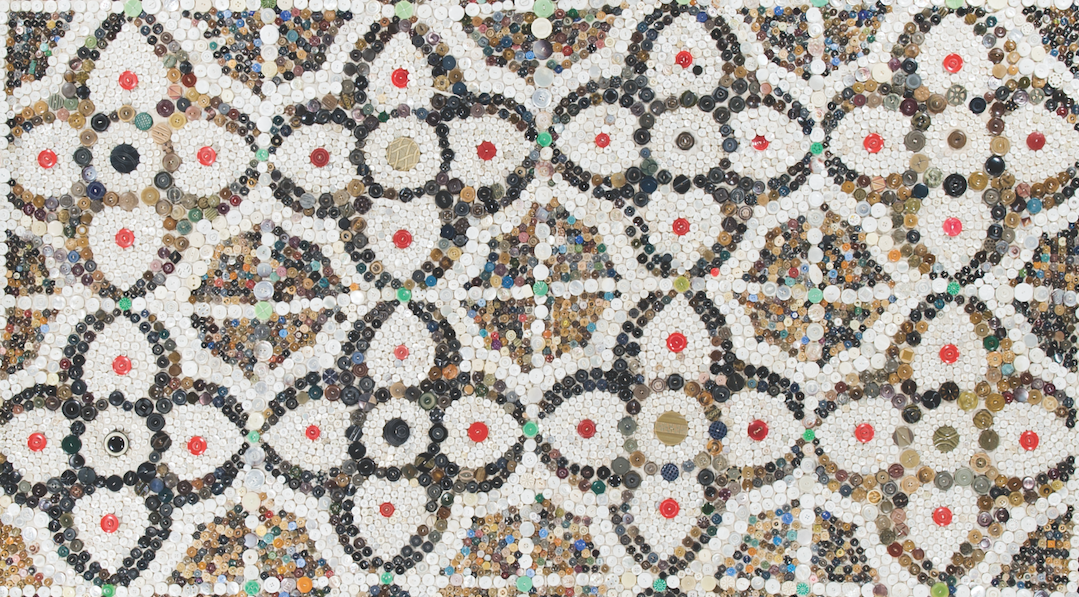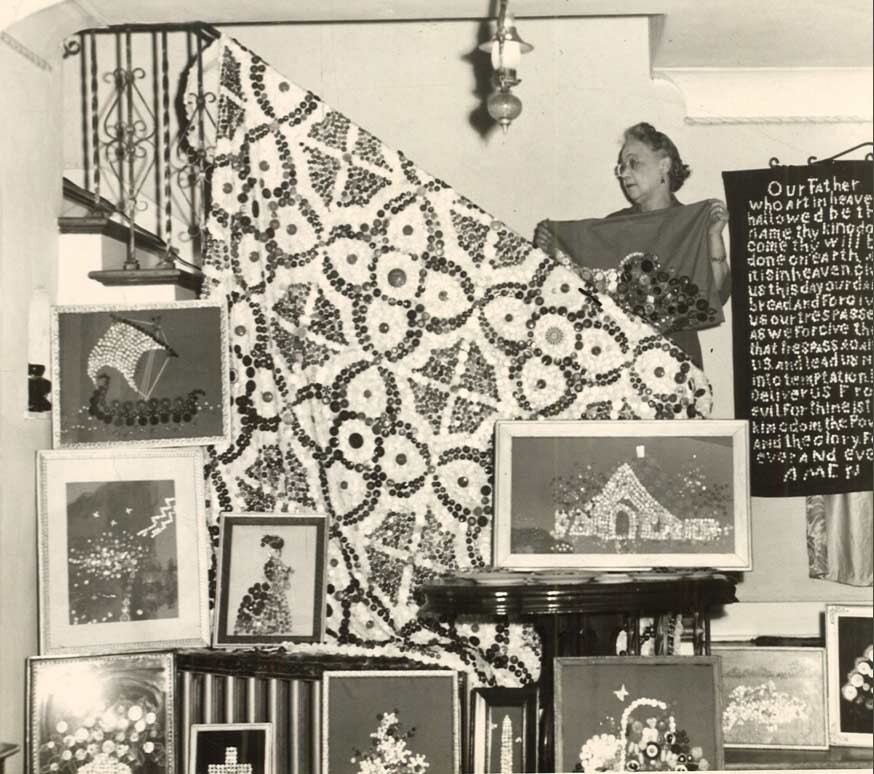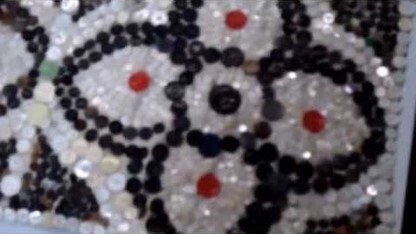
A button is a small, serviceable object, often taken for granted. Yet, Mary Elizabeth Shelby used the humble button to create dazzling effects.
The Kansas City, Missouri, woman who died in 1962 was a button collector who composed mosaics using buttons. A photo taken in the 1940s or 1950s shows her with a dozen such works, including designs featuring a church, an elegant lady, a ship, a flower basket and even the Lord’s Prayer.
Her masterpiece, however, is the “Button Quilt,” an 87-by-79-inch piece of seersucker embellished with 11,923 buttons, hand sewn in a heart motif adapted from a quilt pattern published in the Kansas City Star on May 21, 1938.
Shelby’s grandson, William Shelby, donated the Button Quilt to the International Quilt Study Center and Museum at the University of Nebraska-Lincoln in 2014. William Shelby said his family was familiar with the International Quilt Study Center because his wife, Michele, is a quilt maker and because their son, Andrew, earned a master’s degree in architecture from UNL. He now lives in Omaha.
“We’re pleased the quilt is in the state of Nebraska,” he said. “We know they will be the conservator of that quilt for many years and, after we’re gone, our grandchildren will be proud of that quilt in the collection.”
The quilt weighs 65 pounds. Though it is too heavy and fragile to be hung vertically, quilt study center officials say the unusual work is a popular highlight for “behind-the-scenes” tours of the quilt center’s storage area. For now, the quilt is stored flat in the bottom drawer of a quilt-sized storage unit, where it can be pulled out for viewing.
“It is a fantastic piece – quirky, artistic, surprisingly heavy and inspirational,” said Leslie Levy, the center’s executive director.
Carolyn Ducey, curator of collections, said she hopes to include the quilt in an exhibit of whimsical quilts in 2017.
“It’s really a one-off – its historical significance is that it is so rare and unusual,” Ducey said. “It’s very bold, beautiful pattern. But it also has a sentimental appeal. So many people remember their mom’s button box, everybody’s kind of fascinated with the buttons. For a collector, there’s some amazing examples.”
La Vonne Uffelman, a retired teacher who is an expert on antique buttons, recently examined the quilt and found that it contains many examples of buttons that were popular in the 1920s, 1930s and 1940s. They include celluloid buttons, made of an early polymer that has not been manufactured since before World War II; brown “vegetable ivory” buttons made from tagua palm nuts from South America; green, blue and red plastic buttons manufactured in the 1930s; an array of pearl, sea shell and albacore buttons, some hand-carved; painted aluminum buttons with their color nearly worn away; a few brass military buttons; and even a small pair of shoes in black glass – called a “realistic” button – that could date back to Victorian days.
Quiltmaker Mary Elizabeth Shelby was born in Jefferson City, Missouri, in 1880. She was married shortly after the turn of the 20th Century and pursued a career with the Missouri correctional system, serving as superintendent of the Industrial Home for Negro Girls in Tipton, Missouri, from 1925 to 1933, her family said.
After leaving the corrections department, Shelby retired to her home in Kansas City.
William Shelby was just 10 years old when his grandmother died at 82.
“By the time I was born in 1952, the quilt was already made and possibly had been displayed at different locations,” he said.
In the information he provided to the quilt study center, William Shelby said his grandmother began her button collection hobby after seeing many beautiful and old buttons in her mother’s button box. Her own interest in embroidery, rug making, quilt making and artistic designs made her realize how attractive the buttons would be in making pictures, samplers and embellishing quilts.
William Shelby said he doesn’t know how his grandmother acquired the thousands of buttons she used in the quilt. He is the only child of an only child and there are no living relatives who could tell him more.
According to William Shelby, the quilt placed fourth in a novelty quilt contest at the Missouri State Fair, although he doesn’t know the date. It was displayed at the Home Show held at Kansas City’s Municipal Auditorium during the 1950s. Shelby’s father loaned it to the Old Shawnee Town museum in Shawnee, Kansas, where it was on display for 30 years before being returned to the Shelby family several years ago.










